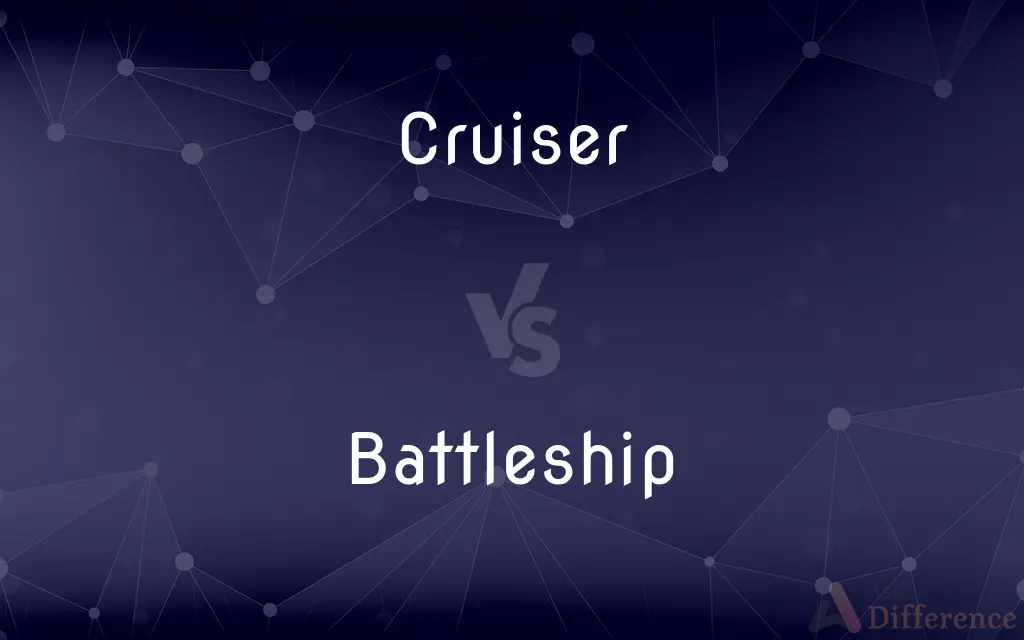Cruiser vs. Battleship — What's the Difference?
By Urooj Arif & Maham Liaqat — Updated on March 25, 2024
A cruiser is a fast, versatile warship optimized for fleet screening and protecting against smaller vessels, while a battleship is heavily armored and armed, designed for frontline engagement and bombarding shorelines.

Difference Between Cruiser and Battleship
Table of Contents
ADVERTISEMENT
Key Differences
Cruisers, being lighter and faster than battleships, serve roles that require speed and flexibility, such as reconnaissance, patrol, and escort duties. In contrast, battleships, with their superior armor and heavier armament, are built to take and deliver significant damage in major naval engagements, focusing on direct confrontations with enemy ships and coastal bombardment.
The armament of cruisers typically includes medium-caliber guns, torpedoes, and anti-aircraft weapons, suited for a variety of threats at sea. Meanwhile, battleships boast large-caliber guns capable of engaging targets over long distances, making them formidable opponents in naval warfare.
In terms of defense, cruisers rely on their speed and maneuverability to evade enemy fire, whereas battleships use their extensive armor plating to withstand hits from enemy shells and torpedoes, embodying the concept of floating fortresses.
Strategically, cruisers often operate independently or as part of smaller task forces, undertaking missions that require extended range and duration, such as showing the flag, commerce raiding, or blockade enforcement. Battleships, however, typically serve as the core of a naval fleet, providing heavy support during major operations and serving as a key asset in achieving naval dominance.
The roles and importance of both ship types have evolved with advances in naval technology and strategy. While the battleship's prominence declined post-World War II due to the rise of air power and missiles, cruisers adapted to modern naval warfare, incorporating guided missiles and advanced electronics for various offensive and defensive roles.
ADVERTISEMENT
Comparison Chart
Primary Role
Reconnaissance, patrol, fleet escort.
Frontline engagement, coastal bombardment.
Speed and Agility
High speed and maneuverability.
Lower speed, prioritizing armor and firepower.
Armament
Medium-caliber guns, torpedoes, anti-aircraft weapons.
Large-caliber guns, secondary armament for closer targets.
Defense
Lighter armor, relies on speed for evasion.
Heavy armor plating, designed to absorb damage.
Strategic Use
Independent operations, extended missions.
Core of the naval fleet, major combat operations.
Adaptation to Modern Warfare
Evolved with missile technology and electronics.
Declined due to advancements in air power and missiles.
Compare with Definitions
Cruiser
Adaptable to modern warfare with guided missiles.
The missile cruiser engaged targets beyond the horizon.
Battleship
Became less prominent with the rise of air power.
The battleship's role diminished as aircraft carriers took precedence.
Cruiser
Essential for showing naval presence and diplomacy.
The cruiser visited foreign ports as a sign of goodwill.
Battleship
Relied on massive guns for long-range engagement.
The battleship's guns fired salvos at targets 20 miles away.
Cruiser
A fast, versatile warship for multiple naval tasks.
The cruiser was deployed for a maritime patrol mission.
Battleship
Served as the centerpiece of early 20th-century fleets.
The battleship led the naval formation into enemy waters.
Cruiser
Often operates independently on extended missions.
The cruiser executed a long-range reconnaissance operation.
Battleship
A heavily armored warship with powerful armament.
The battleship dominated sea battles with its formidable guns.
Cruiser
Designed for fleet protection and anti-aircraft defense.
The cruiser provided cover against enemy aircraft.
Battleship
Designed for direct engagement and shore bombardment.
The battleship provided crucial support during the land assault.
Cruiser
A cruiser is a type of warship. Modern cruisers are generally the largest ships in a fleet after aircraft carriers and amphibious assault ships, and can usually perform several roles.
Battleship
A battleship is a large armored warship with a main battery consisting of large caliber guns, which dominated naval warfare in the late 19th and early 20th centuries. The term battleship came into use in the late 1880s to describe a type of ironclad warship, now referred to by historians as pre-dreadnought battleships.
Cruiser
One of a class of fast warships of medium tonnage with a long cruising radius and less armor and firepower than a battleship.
Battleship
A heavy warship of a type built chiefly in the late 19th and early 20th centuries, with extensive armour protection and large-calibre guns.
Cruiser
A cabin cruiser.
Battleship
Any of a class of very large warships, heavily armored and armed with numerous large-caliber guns. Also called battlewagon.
Cruiser
See squad car.
Battleship
A large capital warship displacing thousands to tens of thousands of tons, heavily armoured and armed with large-caliber guns; now obsolescent and replaced by smaller vessels with guided missiles.
Cruiser
One who attends cruises.
Battleship
A ship of the line.
Cruiser
(cycling) A kind of bicycle that usually combines balloon tires, an upright seating posture, a single-speed drivetrain, and straightforward steel construction with expressive styling.
Battleship
A non-functional rocket stage, used for configuration and integration tests.
Cruiser
A frigate or other vessel, detached from the fleet, to cruise independently in search of the enemy or its merchant ships.
Battleship
A guessing game played on grid paper; see Battleship (game).
Cruiser
(nautical) A class of fast warships of medium tonnage, having a long cruising range but less armour and firepower than a battleship.
Battleship
An armor-plated warship built of steel and heavily armed, generally having over ten thousand tons displacement, and intended to be fit to combat the heaviest enemy ships in line of battle; the most heavily armed and armored class of warship at any given time.
Cruiser
(nautical) A miniature aircraft carrier carrying VTOL aircraft.
Battleship
Large and heavily armoured warship
Cruiser
(nautical) A passenger ship used for pleasure voyages, where the voyage itself and the ship's amenities are considered an essential part of the experience.
Cruiser
(nautical) Any of several yachts designed for cruising.
Cruiser
A police patrol vehicle.
Cruiser
(entomology) Any of various nymphalid butterflies of the genus Vindula.
Cruiser
(entomology) Any dragonfly of the family Macromiidae; a macromiid.
Cruiser
Someone who cruises bars and neighborhoods looking for "action".
Cruiser
One who, or a vessel that, cruises;
Cruiser
A car in which policemen cruise the streets; equipped with radiotelephonic communications to headquarters
Cruiser
A large fast warship; smaller than a battleship and larger than a destroyer
Cruiser
A large motorboat that has a cabin and plumbing and other conveniences necessary for living on board
Common Curiosities
What role did battleships play in historical naval conflicts?
Battleships served as the backbone of fleets, engaging in major sea battles and providing crucial fire support for land operations.
Are cruisers still relevant in today's navies?
Yes, cruisers remain relevant by serving as command ships, missile platforms, and in roles requiring speed and flexibility.
What made battleships vulnerable to air attacks?
Battleships' slower speed and large profile made them easy targets for faster, more maneuverable aircraft.
How have cruisers adapted to modern naval warfare?
Modern cruisers incorporate advanced missile systems and electronics, enabling them to fulfill a range of offensive and defensive roles.
What distinguishes a cruiser from a battleship?
Cruisers are designed for speed and versatility, focusing on fleet screening and protection, while battleships prioritize heavy armor and firepower for direct combat and bombardment.
What technological advancements impacted battleships the most?
Aircraft carriers and missile technology greatly impacted battleships, limiting their effectiveness in modern naval warfare.
Why did battleships decline in importance?
The advent of air power and missile technology reduced the battleship's effectiveness, making them vulnerable to attacks from beyond their engagement range.
Can cruisers engage in direct combat with battleships?
While cruisers can engage in combat with battleships, their strategy relies more on speed and maneuverability rather than direct firepower exchanges.
What strategic advantages do cruisers offer?
Cruisers offer strategic flexibility, capable of performing solo missions, showing naval presence, and executing long-range tasks.
How do cruisers and battleships differ in their defense strategies?
Cruisers rely on agility to avoid damage, while battleships use their heavy armor to withstand attacks.
How does the armament of cruisers compare to battleships?
Cruisers carry medium-caliber guns and missiles suited for a variety of threats, whereas battleships are equipped with larger guns for maximum firepower.
How have naval strategies evolved with changes in warship designs?
Naval strategies have shifted towards multi-dimensional warfare, emphasizing versatility, stealth, and long-range capabilities over sheer firepower.
Are there any battleships still in active service?
As of the last known data, battleships are no longer in active service, having been replaced by more versatile and technologically advanced ships.
Did battleships have any weaknesses?
Despite their firepower and armor, battleships were vulnerable to submarine and air attacks, highlighting weaknesses in their defense against modern weapons.
Why are cruisers considered versatile?
Their speed, armament, and technological capabilities make cruisers adaptable to various naval warfare roles, from escorting to strike missions.
Share Your Discovery

Previous Comparison
Information vs. Communication
Next Comparison
Architecture vs. VignetteAuthor Spotlight
Written by
Urooj ArifUrooj is a skilled content writer at Ask Difference, known for her exceptional ability to simplify complex topics into engaging and informative content. With a passion for research and a flair for clear, concise writing, she consistently delivers articles that resonate with our diverse audience.
Co-written by
Maham Liaqat













































